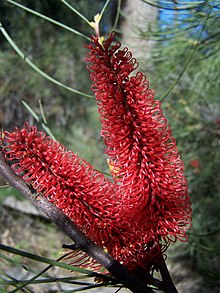Hakea bucculenta
| Hakea bucculenta | |
|---|---|

| |
| H. bucculenta, Kings Park | |
| Scientific classification | |
| Kingdom: | Plantae |
| Clade: | Tracheophytes |
| Clade: | Angiosperms |
| Clade: | Eudicots |
| Order: | Proteales |
| Family: | Proteaceae |
| Genus: | Hakea |
| Species: | H. bucculenta
|
| Binomial name | |
| Hakea bucculenta | |

| |
| Occurrence data from AVH | |



Hakea bucculenta, commonly known as red pokers,[2] is a large shrub in the family Proteaceae endemic to Western Australia. A spectacular ornamental shrub with red or orange flowers that appear in rod-like blooms in leaf axils for an extended period from May to November.
Description[edit]
Hakea bucculenta is non-lignotuberous upright, rounded, bushy shrub that typically grows to a height of 1.5 to 4.5 metres (5 to 15 ft) but can reach as high as 7 m (23 ft). Smaller branches have irregular patches of flattened silky hairs becoming smooth at flowering. The leaves are a narrowly linear shape with a slight curve and 90 to 200 millimetres (4 to 8 in) long and 1 to 3 millimetres (0.039 to 0.118 in) wide. Each leaf has fine ribbing, conspicuous veins with an obvious mid-vein on both sides and ending with a sharp point. Each inflorescence is made up of 250 to 450 showy orange or bright red flowers in racemes up to 15 cm (6 in) long on a smooth stem 8.5–13.5 cm (3–5 in) long. Flowers appear from May to November, the main flush in spring. The pedicel is smooth and perianth a bright red. The style 18–21 mm (0.7–0.8 in) long. The woody fruit are egg-shaped 1.7–2.5 cm (0.7–1 in) long and 1–1.5 cm (0.4–0.6 in) wide. The grey smooth fruit appear in clusters of 3–16 on a long stem or attached directly onto the branch. Each fruit is divided into a thick body ending a blunt beak. The blackish or brown seeds are obliquely obovate with a length of 16 to 18 mm (0.63 to 0.71 in) and a width of 7 to 9 mm (0.28 to 0.35 in) with a single wing.[3][4][5][6][7][8][9]
Taxonomy[edit]
Hakea bucculenta was first formally described by the botanist Charles Austin Gardner in 1936 and published in the Journal of the Royal Society of Western Australia.[1] The specific epithet (bucculenta) is derived from the Latin word bucculentus meaning "with full cheeks",[10] which refers to the shape of the fruit.[3]
Distribution[edit]
Hakea bucculenta is endemic to coastal areas in the Gascoyne and Mid West regions between Shark Bay and Geraldton in Western Australia. Grows on coastal sand plain heath or mallee, roadsides verges in sandy, loam or clay-based soils.[11]
Cultivation[edit]
Hakea bucculenta is sensitive to dieback and thus difficult to keep alive in areas of high humidity. It can be successfully grafted onto Hakea salicifolia. It is most commonly propagated from seeds which germinate in about three to four weeks. Cuttings can also be used but usually have a low rate of success. It grows well in a sunny position out of the wind in well-drained soils; it will tolerate both drought and frost.[2][5]
References[edit]
- ^ a b "Hakea bucculenta". Australian Plant Name Index (APNI), IBIS database. Centre for Plant Biodiversity Research, Australian Government, Canberra. Retrieved 15 February 2019.
- ^ a b Young, J A (2006). "Hakeas of Western Australia:A Field and Identification Guide". J A Young. ISBN 0-9585778-2-X.
- ^ a b "Hakea bucculenta". Flora of South Australia. South Australian Government. Retrieved 20 January 2019.
- ^ "Hakea bucculenta". FloraBase. Government of Western Australia. Retrieved 20 January 2019.
- ^ a b "Hakea bucculenta". Flora of Australia Online. Australian National Botanic Gardens. Retrieved 20 January 2019.
- ^ Wilson (ed), Annette; Barker, Robyn M.; Haegi, Laurence A.; Barker, William R. (1999). "Flora of Australia" Vol.17B Proteaceae 3 Hakeas to Dryandra. Canberra/Melbourne: ABRS-Department of Environment & Heritage. ISBN 0-643-06454-0.
{{cite book}}:|last1=has generic name (help) - ^ "Hakea bucculenta". Australian Native Plant Society (Australia). 2008. Retrieved 15 February 2019.
- ^ Gardner, Charles A. (1936). "Hakea bucculenta". Journal of the Royal Society of Western Australia. 22: 123. Retrieved 15 February 2019.
- ^ Grieg, Denise (1999). "Field Guide to Australian Wildflowers". New Holland Publishers (Australia). ISBN 1-86436-334-7.
- ^ Brown, Roland Wilbur (1956). The Composition of Scientific Words. Washington, D.C.: Smithsonian Institution Press. p. 169.
- ^ Holliday, Ivan (2005). "Hakeas a Field and Garden Guide". Reed New Holland. ISBN 1-877069-14-0.
External links[edit]
- "Hakea bucculenta". Flora of Australia Online. Department of the Environment and Heritage, Australian Government.
